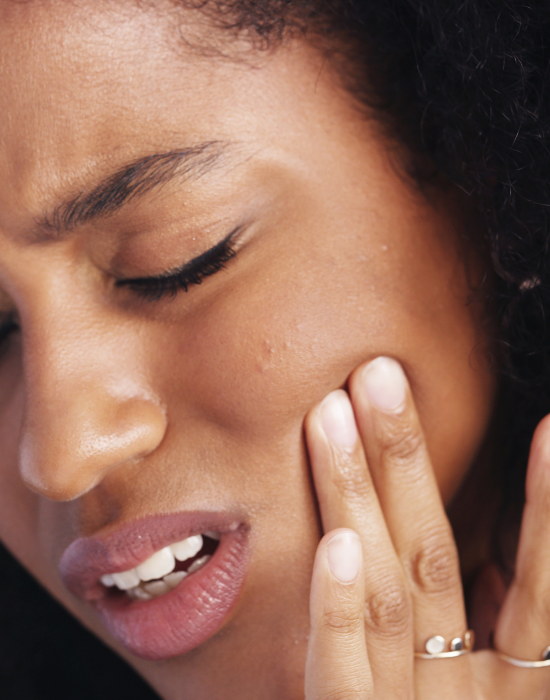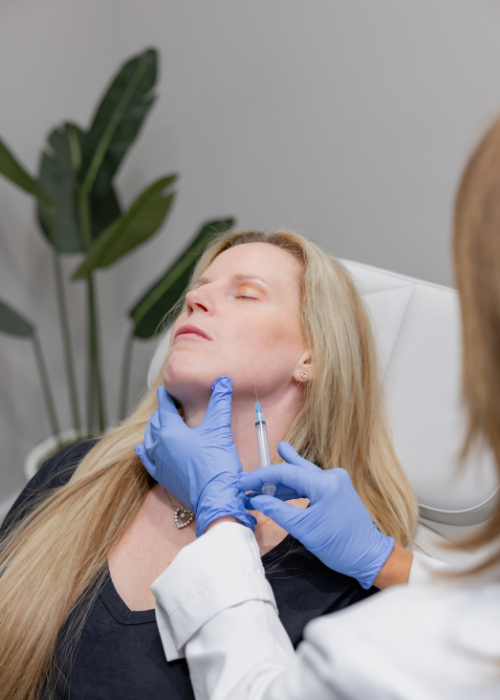Understanding TMJ
The temporomandibular joints (TMJ) are the hinges that connect your jawbone to your skull and allow you to talk, chew, and yawn. When these joints are not functioning properly, it can result in TMJ disorder, a condition marked by jaw pain, stiffness, and other uncomfortable TMJ symptoms. At Thrive Wellness and Aesthetics, we offer nonsurgical treatments to help relieve facial pain, restore function, and improve your quality of life.
Potential Causes
Chronic jaw movement can place strain on the chewing muscles, contributing to ongoing pain and discomfort. More specifically, TMJ disorders can arise from several underlying issues, including:
- Overactive jaw muscles caused by grinding or clenching (bruxism)
- Gum chewing or nail biting habits
- Misaligned jaw joint or teeth
- Injury or trauma to the jaw or face
- Stress and poor relaxation techniques
- Inflammatory medical conditions like arthritis
Who is Affected by TMJ?
TMJ disorders can affect people of all ages, although they are more common in women between the ages of 20 and 40. TMJ symptoms range from clicking or popping in the jaw joint, to headaches, earaches, and restricted jaw movement. Pediatric patients may also experience symptoms, though treatment approaches may differ. If left untreated, TMJ can lead to chronic pain and significant impairment in daily life.
Services for TMJ
Thrive Wellness and Aesthetics offers neuromodulator injections as part of our approach to TMJ relief:
Botox
Botulinum toxin injections—commonly known as Botox injections—are an FDA-approved and effective option to help manage TMJ disorder. When injected into the chewing muscles and facial muscles, Botox Cosmetic works by relaxing muscles and blocking nerve endings that signal contraction, offering targeted pain relief and reducing facial pain.
Injecting botulinum toxin type A has shown promise in clinical trials in reducing TMJ symptoms and improving jaw function. While not a cure, it can be a powerful tool in managing symptoms for patients who prefer to avoid more invasive options that involve surgery. Botulinum toxin products like Botox are also used to treat other conditions such as chronic migraine, cervical dystonia, lower limb spasticity, and even overactive bladder and urinary incontinence.
Where to Get Started
At Thrive, our experienced providers will conduct a thorough evaluation to determine if Botox treatment is right for you. We’ll assess your medical history, current symptoms, and any use of prescription medications, such as blood thinners, which may affect your eligibility. If you’re seeking relief from TMJ pain, our team of skilled healthcare professionals and TMJ specialists will develop a personalized care plan to support your healing and wellness journey; contact Thrive Wellness and Aesthetics today.
Does Botox for TMJ disorder really work?
Are there any side effects?
What should I avoid after Botox treatment for TMJ?
How does Botox help relieve TMJ pain?
What are common symptoms of TMJ disorders?
What causes TMJ?
Can stress impact TMJ pain?
What happens if TMJ disorder is left untreated?
Is teeth grinding the same as TMJ?
Where is the masseter muscle located?
What are the main functions of the masseter muscle?
What activities can cause the masseter muscle to become overactive?
How to relax the masseter muscle?
CONTACT US
Our office is a hybrid medspa and wellness center. Whether you need a quick refresh or desire to make a long-lasting change in your health, our team can help. To schedule a treatment or consultation, or if you would like more information on pricing, please contact us below. A member of our staff will contact you straight away. Upon submission of the contact form, you will be redirected to our pricing page to view our price list.
Dana Protomastro, AGPCNP-BC, is a certified primary care nurse practitioner who is a proven leader in the medical community. She has over 25 years of experience delivering exceptional care with a holistic approach in perioperative care, plastic surgery, and aesthetic medicine.
Dana has introduced cutting-edge, non-invasive technologies into her practice as wellness-based alternatives to surgical procedures. She works closely with men and women of all ages to determine the best treatment method for their individual needs. Some of her specialties include laser treatments, micro needling, Botox, fillers and the integration of skincare products.






 Explore Our
Explore Our